The Chernobyl Disaster
The Hiroshima Syndrome infects the world
The single-most important event which brought the psychic damage of the Hiroshima Syndrome to the world-at-large was the accident at the Chernobyl nuclear power plant. The explanation of the Chernobyl accident, and why it could only happen to a nuclear power plant of its unique design, should be preceded by defining a few "nuclear" terms using as much everyday language as possible.
"Critical vs. promptly supercritical"
The word "critical" relative to reactors gets a lot of negative connotation in science-fiction stories. It's as if a reactor going critical is to be avoided like the plague. Nothing could be further from the truth. In order for a reactor to have a chain reaction of splitting U-235 atoms, it must enter into a condition called "critical". A reactor becomes critical when the chain reaction has begun, and continues to occur. When an operating reactor has the same number of fissions occur every second, it is in the state of being "critical". It's much like your car engine. Your car engine essentially goes critical when it starts up and idles. It continues to run because the number of times the spark plugs ignite is the same every second.
The reactor criticality condition changes as power level is changed by the operator. When power level is increasing, it becomes slightly supercritical, which means the fission reaction rate is going up until it reaches the new, desired level. As power level is decreased by the operator, the fission rate goes down, which makes the fission reaction somewhat subcritical. All routine criticality transients make subtle changes to the number of fissions occurring at any moment, at least they seem subtle from our everyday point of view. But, on the atomic level, these changes can be considerable.
Changes on the atomic level occur over time periods measured in millionths of a second, and can escalate faster and faster as time passes. Changes on the atomic level can result in power oscillations occurring faster than the human mind can reasonably grasp and human technology can accurately monitor. One such rapid change on the atomic level is called "prompt criticality", when the increase in number of fissions every fleeting moment is raised so quickly that power level seems escalate in a virtual instant. To the human mind it can seem as if reactor power level increases from virtually nothing to many percent of full power in less than a second, and jump even more the next second, and so on. If power level jumps from less than 1% to 4% in one second and is not restrained, it can independently increase to 16% after two seconds, 64% after 3 seconds, 128% after 4 seconds, more than 500% after 5 seconds, over 2000% after 6 seconds, and a full 10,000% after just over seven seconds. Reactor power transients this extreme are highly unlikely for any reactor, but not impossible if-and-only-if the reactor is a very special kind and the conditions surrounding reactor operations are of a very unstable nature. The best way to avoid the possibility of a prompt supercritical condition is to not build that "very special kind" of reactor! Never! Ever! But, the USSR built that "special" kind of reactor, nonetheless.
"Slowing Down Neutrons"
Next, we should turn to the process of neutron moderation, a necessary process in allowing sufficient fission levels in low concentration Uranium fuel. As described elsewhere on this site (see "The Uranium Explosive Myth"), neutrons freshly released from the splitting of U-235 and Pu-239 are a million times too energetic to continue a sustainable chain reaction the low concentration fuel found in a power plant reactor. In nearly all nuclear power plants world-wide, the material that slows down the neutrons is the water in the reactor. Water is the "moderator" of the neutron energy level.
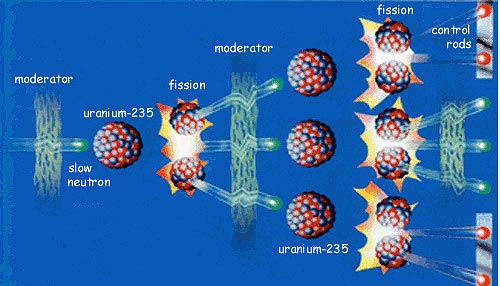
Because water expands as it heats up, the water molecules essentially move further apart from each other as reactor temperature increases, and the water loses some of its moderating efficiency because each neutron has to travel a tiny but longer between collisions. This naturally drives the fission rate somewhat subcritical and the number of fissions per second goes down. To compensate for this as the reactor heats up, the operator slowly withdraws the neutron-absorbing control rods from part of the fuel core, in order to keep the fission rate going up with increasing temperature. 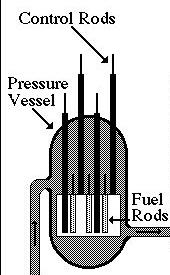
This is essentially how water-moderated reactors world-wide increase their power levels in order to boil enough water to make sufficient steam to spin the turbines. As operating temperature goes up, control rods must be moved slowly out of the core from time to time in order to maintain the desired reaction-rate. Once the desired operating pressures and temperatures in the fuel cell are achieved, power level can be fine-tuned by increasing and decreasing the flow of water through the reactor with no further control rod movement. Reduce water flow a bit, and reactor power goes down because the water stays in the core a bit longer, warms up, expands (becomes less dense), and slows down fewer neutrons. Increase the water flow a tad, and power level raises a little because the water stays in the core for a shorter period of time, cools down a little, becomes slightly more dense, and slows down more neutrons. In water-moderated reactors, temperatures and power levels change in direct opposition to each other… as temperature goes up, reactor power naturally goes down… as temperature goes down, reactor power naturally goes up. The nuclear term for this is "the negative temperature coefficient of reactivity" (NTC). Let's call this natural phenomena simply the Negative Temperature Effect (NTE).
Another important concept to be explained is yet another nuclear phrase "void coefficient of reactivity". This can also be correctly re-named the Steam Effect (SE). In water-moderated reactors, any steam bubbles in the fuel core are 20 times less dense than the liquid water, so steam is a many, many times poorer neutron moderator than the liquid. As the volume of steam in the core goes up, fewer fissions occur, and power goes down. As the volume of steam goes down, power goes up. Let's call this natural phenomena simply the Negative Steam Effect (NSE). All water-moderated reactors operate on the two natural phenomena NTE and NSE.
Unfortunately, the reactor at Chernobyl was a different breed of reactor; unique to the USSR. It's acronym is RBMK-1000. The only places one might find an RBMK reactor is Eastern Europe & Russia (i.e. the former USSR). RBMK is so uniquely designed that it does not work on the NTE or NSE. In fact, it works on totally opposite principles we might term as the Positive Temperature Effect (PTE) and Positive Steam Effect (PSE). The PTE occurs in RBMK reactors because water is not the moderator of the neutrons. The fuel cells are encased in a very different moderator; graphite. At the high temperatures routinely occurring during operation of the RBMK-1000 reactor, graphite gets strange; instead of expanding and losing density as temperature increases, density actually increases as temperatures go up. Wierd, but true. The hotter the graphite, the better it is at slowing down neutrons. Temperature goes up, and power goes up. Temperature goes down, and power goes down. Thus, RBMK reactors operate on the relatively un-natural, and highly volatile Positive Temperature Effect.
Surrounding the graphite-wrapped fuel cells are "tubes" through which water flows in order to keep the graphite and fuel from getting too hot. The water is allowed to boil inside the tubes, and the steam is sent to the turbines which drive the electric generators. 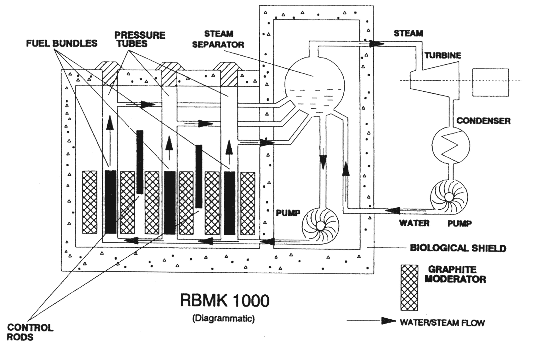
The water in the cooling tubes slows down a small fraction of the core's neutrons, to be sure. But most of the neutron moderating occurs in the graphite, which greatly overwhelms the Negative Temperature Effect the water might cause. In the RBMK, as the volume of steam increases in the water tubes there is less water moderation, allowing more fast neutrons to stream directly into the graphite, which slows these additional neutrons down and heats up the graphite a bit more in the process. More heat in the graphite produces a higher volume of slow neutrons, and power level increases. When the volume of liquid water in the cooling tubes increases (less steam), the water moderates slightly more neutrons and there are fewer fast neutrons for the graphite to moderate at any given moment, which keeps the graphite from becoming too hot and slowing down neutrons at a higher frequency than would be desired. Thus, when the steam volume increases in the RBMK's water cooling system, reactor power level increases. Conversely, when steam volume goes down, power goes down. The RBMK-1000 reactor thus operates on the relatively un-natural, and quite volatile Positive Steam Effect in concert with the PTE. RBMKs are the only power plant reactors in the world that operate on the PTE and PSE principles concurrently, and this makes the RBMK reactors the most dangerous reactors imaginable.
"Containment"
Perhaps the singular aspect of the Chernobyl plant that was most responsible for the severe radiation releases to the outer environment was it's lack of a containment structure surrounding the reactor. All of the world's reactors for the production of electricity, other than the RBMK, are surrounded by massive walls of solid concrete. The outer wall is typically called a "Containment Building" or "Reactor Building", usually made of steel-reinforced concrete 3-5 feet thick on the sides, 2-3 feet thick on the top, and 9-12 feet thick on the bottom. In the United States, this outer building is usually in the shape of a cylindrical domed structure.
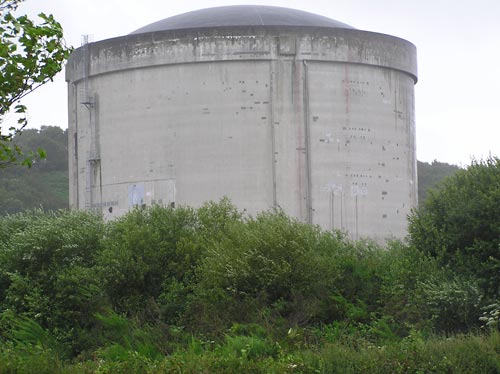
These outer walls are the only modern man-made structures built to survive the crash of a super-jet liner. Immediately inside the domed outer building is an all-encompassing air-tight steel "liner" which is at least 1" thick. The steel liner can survive pressure surges up to and above 50 p.s.i. Most of the space within the "liner" is open. A typical liner is over 120 feet high and about 50 feet in diameter. Deep inside the air-tight liner is another massive concrete structure, often called a "drywell", the walls of which are usually 5 feet thick. The reactor is inside the drywell, mounted on a circular "pedestal" with walls about 6 feet thick, and surrounded by a 4 foot thick concrete "Biological Shield". 
Unfortunately, the "compartment" surrounding the Chernobyl reactor had none of this surrounding it. The compartment containing the reactor was made of steel-reinforced concrete a few feet thick, and the base mat under the reactor is several feet thicker. On top of this compartment was a cylindrical 1000 ton concrete and steel "biological shield" (UBS), considered heavy enough to prevent the release of dangerous amounts of radioactive isotopes just by its sheer weight alone. It was niether bolted nor welded in place, nor attached in any form to its support structure. It just sat there! It should be mentioned that this removable "shield" does make reactor refueling much easier than it would be otherwise. However, there was nothing surrounding the Chernobyl reactor like the enormous multi-layered, air-tight containments which encase the nuclear power plant reactors found around the world.
Enough already...what happened at Chernobyl?
On the evening of April 25, 1986, the operators at Chernobyl had slowly reduced the production of electricity from one of their four nuclear power generating plants, and had lowered its reactor power to less than 5% while preparing to refuel some of the core. Before completely shutting down, they were planning to test the operation of their emergency electric power system, which was designed to automatically recover from a complete loss of electricity to the plant. The emergency generators were built to start up and supply emergency power within 15 seconds of a complete loss of normal electricity supplies. This test had been under consideration by the Soviets for a number of years, but had never been actually performed. This would be the first test of the emergency system on any RBMK, anywhere.
Soviet reactor analysts reasoned that when electric power would be lost, the turbine-generators would still be spinning, which could keep a little electricity flowing through the plant's electrical system. So, there need not be a total loss of electricity before the emergency generators restored everything. There should still be enough electricity from the decellerating turbine-generators to keep the pumps sending water into the core cooling system, albeit at a much lower rate of flow. In case reactor temperature and power level started to increase too fast (due to PTE and PSE), there should also have been enough residual electricity from the turbines for the operators to rapidly insert (SCRAM) the core's neutron absorbing control rods, stopping the fission chain reaction dead in its tracks. If this failed, it was further hypothesized that reactor power would never go much beyond 100 percent before electrical power was restored, which should occur within 15 seconds. If there were a rapid power surge up to 100% power, it might damage some of the fuel cells in the reactor, but not enough to be unsafe. Numerous prior tests on the automatic emergency generators demonstrated that they worked exactly as they were designed to work. Confidence was high for a successful test. It turns out the beliefs of residual electricity from the turbine-generators and the hypothetical limit to a reactor power surge were incorrect, and the results were disastrous.
The test began on the morning of October 26. In order to make the test a "worst case" scenario, electricity for the pumps sending water to the cooling tubes in the reactor was disconnected, allowing the huge pumps to begin coasting down in their rate of rotation. This was the first, and perhaps the most significant of many operational errors. 30 seconds after pump coast-down had begun, the operators started the official test and shut off all electricity in the rest of the plant. Almost immediately the emergency generators began to start, but it would be 15 seconds before they would be up to design speed and warm enough to automatically supply electricity. Most of the people in the control room were watching the monitoring devices on the emergency generators, which were considered to be of greatest concern. Dutifully maintaining his focus on the reactor monitors, the reactor operator was surprised to see power level had somehow dropped to less than 1% as soon as the test started, which was entirely unexpected. At about 4 seconds into the test, the operator noticed that reactor power was no longer less than 1%, but was suddenly over 50% and increasing. The gauge he was looking at then jumped to just over 120%, which was the gauge's upper limit. He immediately tried to rapidly insert control rods and stop the accelerating power increase. Some of the control rods began to move into the core, but not all of the control rods planned for in the test moved. And, the control rods that did move were going into the core very slowly.
At approximately seven seconds into the test (two seconds after the control rods began moving), a loud explosion was heard from the direction of the reactor compartment area, along with a considerable shocking and shaking to the control room. At the same moment, the reactor operator noticed the control rods were no longer moving into the core. Three seconds later, another explosion was heard (some sources say there were two) and large fires suddenly broke out in several areas outside of the control room. A report came in over head-sets from a worker stationed out in the plant that the 1000 ton, concrete-filled, steel-covered Upper Biological Shield (UBS) which closed off the top of the reactor compartment, had shifted drastically with the first explosion, causing it to fall into the reactor compartment. The man calling in the report also said a worker standing next to the UBS had disappeared in the explosion (his body was never found) and another standing nearby was severely injured and bleeding (he later died). Ten seconds after the test of the emergency electrical system had begun, the worst nuclear power plant accident in the history of the world had happened, and would continue to happen for more than 2 weeks.
What happened inside the reactor?
Chernobyl's horrid accident has been the most studied and researched industrial calamity in what used to be the USSR. Basically, here's what seems to have happened inside the reactor before, during, and after the events summarized above…
When their electric power was shut off, the residual electricity in the pumps sending water to the cooling tubes in the reactor surged through the pump motors much faster than had been predicted. This initially increased cooling water flow to the core, reducing the volume of steam, and the PSE made reactor power rapidly drop to below 1%. No more than two seconds into the test, the cooling water pumps had so little residual pumping ability that they completely stopped and the water in the cooling tubes began to boil rapidly, making a large amount of steam. This caused the already-hot graphite to heat up some more, and slowed down an increasingly higher number of neutrons coming from the fuel, as is the case with the PTE. The rate of fissioning went up with it, and went up fast. More fissions meant more heat to boil more and more water, and an ever increasing influx of neutrons for the graphite to moderate. The graphite heated up faster and faster with each fraction of a second. More heat, making more steam, making the graphite hotter, moderating more neutrons, fissioning more fuel, making even more heat… a horribly vicious cycle which was escalating at a prodigious rate. To make the situation even worse, the tips of RBMK control rods are made of graphite. Thus, when the control rods slowly re-entered the core, the graphite tips further accellerated the slowing down of neutrons and the already-accellerating power level sky-rocketed!
At this point Chernobyl experienced the most rapid increase in reactor power level ever recorded, anywhere, at any time. The reactor had effectively become promptly supercritical when the graphite tips on control rods began to enter the core, and the power level was increased exponentially! At seven seconds into the "test", all of the cooling water tubes in the core over-pressurized and burst from the sudden, enormous surge of heat into the mixture of steam and liquid, resulting in a titanic steam explosion. (The first explosion heard and felt in the control room) Hindsight estimates on reactor power at the seven second mark run the gamut from 1000% to in excess of 10,000%! The actual power level will probably never be precisely known, but it was much, much higher than would ever have been thought possible by Soviet analysts. In a reactor operating on PTE and PSE at the same time, power can escalate with astronomical speed… and it did! Regardless, this first explosion caused the supports for the 1000-ton UBS to collapse, allowing it to drop into the reactor compartment and crush at least half of the reactor fuel cells.
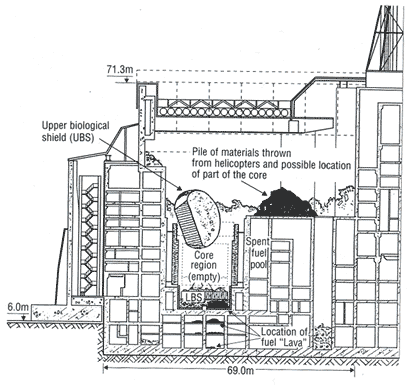
The second explosive event, some ten seconds into the accident (at this point, it wasn't a "test" any more), seems to have been caused by a high concentration of hydrogen mixing with the air in and around the crushed reactor, pouring into the outer building, and an electrical spark set it off. The large volume of hydrogen was produced by immediate contact between the super-heated steam and pieces of the fractured zirconium tubing which had previously held the Uranium fuel pellets in place inside the graphite. Tiny fragments of the exploding water cooling tubes had pulverized the other metallic materials in the reactor's core, allowing the steam-Zirconium reaction to occur at a very high rate. This produced terrific quantities of hydrogen in but a few seconds. The resulting Hydrogen explosion further-weakened the integrity of the reactor core the UBS had not crushed after the first explosion, such that the whole of the core collapsed under the great weight of the UBS. Completely crushed and compressed under the considerable weight of the UBS, some of the Uranium fuel became hot enough to burn through the floor and into the catacomb-like lower support area. Much of the fuel that burned its way into the building's lower cavaties was molten.
Either because of the monstrous initial steam explosion, or due to the subsequent hydrogen gas explosion, or most likely a combination of the two, a large, gaping hole had been blown through the superstructure above the reactor compartment, and through the roof of the outside building. Because there was no outer containment structure, the explosions had created a very efficient chimney, open to the outside world.
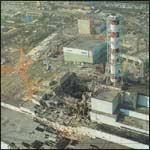
Almost immediately, the crushed fuel cell inside the building began releasing raw fission products (waste atoms) from the severely over-heated Uranium at a rapid rate. The heat of the hot, crushed fuel, plus the hot steam still in the compartment, lifted the radioactive mess up through the open roof and more than a kilometer into the air. The wind direction at the time sent the plume on a northwesterly path. The production of steam stopped in about a day. However, the hot fuel, mixed with graphite, continued to fission at a relatively low level which kept making enough fresh fission fragments and provided enough heat to keep the flow of radioactive material continually billowing invisibly out of the huge hole in the roof. There seemed to be no way to stop it.
Early on the second day, helicopters began dropping large bags of neutron-absorbing materials on top of the crushed reactor, through the hole in the roof. The radiation doses to the pilots, in the middle of the radioactive plume above the hole in the roof, became life-threatening. It was then decided to make high-level drops, with the helicopters moving quickly across the opening, much like dropping bombs from moving planes, in order to minimize the pilot's radiation exposure. Their aim was only fair, at best, and additional damage was done to the rooftop area, opening an even bigger hole. The helicopter drops did not seem to be reducing the amount of radioactive material being disgorged, either. Undaunted, the air-drops valiantly continued. But, something else had to be done, and done quickly. Everyone within 30 kilometers and downwind of Chernobyl was being evacuated, but a sufficient wind shift would send the radioactive plume toward the ancient, historic city of Kiev, and nobody wanted that to happen.
It took more than a week before a viable plan to stop the uncontrolled release of raw radioactive material into the environment was formulated. It took another two days to make it happen after the plans were put into effect. Tons upon tons of liquid nitrogen were continually pumped into the massive catacomb-like support area below the floor of the reactor compartment, eventually freezing the completely destroyed reactor fuel cell. By freezing the area, the flow of radioactive gasses ceased. After the radioactive gas flow ceased, workers kept pumping in liquid nitrogen while hundreds upon hundreds of truckloads of fresh, wet concrete were poured into and on top of the reactor compartment, as well as the rest of the decimated building. On the 15th day of the Chernobyl accident, the enormous concrete mass had fully set up and solidified, so the liquid nitrogen was no longer needed.
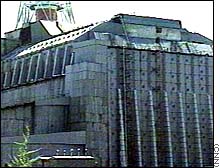
One of the largest man-made mausoleums since the building of the great pyramids had been constructed. The release of radioactive material had ended. The accident at Chernobyl was over.
Aftermath
The physical harms due to the accident were great, both in the square miles of land that will be deemed unlivable for decades (if not longer) and the cost in human lives and suffering. In addition to the two plant workers killed at the onset of the accident, another 28 died of over-exposure to radiation as a result of fighting the numerous fires on the plant surfaces surrounding the reactor compartment, and the failed effort to bring the radioactive material releases under control. Many of the victims were valiant helicopter pilots. Some 500 additional emergency workers and power plant staff were hospitalized for a variety of injuries and health problems, of which 247 were diagnosed with "acute radiation syndrome". Of these, some 22 have died as of 2005 of possible radiation-related causes. Thus the "short term" loss of life numbered 50 people.
Perhaps the most objective and independent report on health effects occurred in 2006, when the findings of the Chernobyl Forum was presented to the Woodrow Wilson International Center for Scholars. The Forum is a group which includes representatives of prestigious international organizations (e.g. United Nations Development Program, the World Health Organization, and the International Atomic Energy Agency), regional researchers (Russian, Ukrainian, and Belarusian), and numerous international scientists and health experts. The Chernobyl Forum found evidence of serious health consequences among the 600,000 “liquidators” who participated in the clean-up work after the accident—including increased rates of leukemia and other cancers, increased rates of cardiovascular disease, and higher risk of cataracts. Using the Linear-No Threshhold Hypothesis, the forum predicted that there will be 4,000 premature deaths directly attributable to radiation exposure among this specific group, in addition to 50 who died from radiation poisoning and physical injuries immediately following the accident. Another health consequence has been high rates of thyroid cancer among children who were exposed to contaminated milk. Some 1800 thyroid cancers were discovered in the exposed children over the three years following the accident, which seems frightening on the surface. But because of early detection and treatment, all of the children survived, grew, and now lead productive adult lives. One subsequently died in 2005, but the cause of death was not the radiation exposure.
However, the health effects on the nearly 5 million members of the public-at-large exposed to Chernobyl's 15 days of atmospheric releases at greater than 1 millirem, have been considerably less. Truth be told, the medical records are astonishing. To be blunt, no negative long-term health effects have been detected in the monitored population, other than those that could have been medically anticipated if the Chernobyl accident had never happened. The 2000 UNSCEAR report on the Chernobyl-exposed population said, "…there is no evidence of a major public health impact attributable to radiation exposure 14 years after the accident. There is no scientific evidence of increases in overall cancer incidence or mortality or in non-malignant disorders that could be related to radiation exposure." In addition, the 2005 IAEA report on Chernobyl states, "Most emergency workers and people living in contaminated areas received relatively low whole body radiation doses, comparable to natural background levels. As a consequence, no evidence or likelihood of decreased fertility among the affected population has been found, nor has there been any evidence of increases in congenital malformations that can be attributed to radiation exposure." The 2006 Chernobyl Forum also did not find any reliable evidence of long term negative health affects among the 5 million people living in contaminated regions of Ukraine, Belarus, and Russia. No physical deformities or mutations have occurred in the children, or anyone else, for that matter. This includes the wildlife now living in the evacuation (exclusion) zone around the Chernobyl reactor site.
Perhaps the most ubiquitous and misleading “fact” found in all Chernobyl 25th anniversary news reports, is that Chernobyl released 400 times more radiation than Hiroshima, subtly but significantly suggesting that Chernobyl was 400 times worse than Hiroshima. The reality is that Chernobyl released about 400 times more fission products than Hiroshima, but the radiation exposures from Chernobyl were thousands of times less than Hiroshima. This is because most of the bomb's radiation exposures were not from fission fragments! Then where did the bomb's enormous, deadly radiation exposures come from, and how does it compare with Chernobyl.
- Why more fission products from Chernobyl? Let's look at the numbers. The seriously damaged reactor fuel cell at Chernobyl had accumulated fission products for years. On the other hand, the bomb burst at Hiroshima produced fission products for no more than a second! Let's say the average fuel cell at Chernobyl has been accumulating fission products for 2 years (roughly 63 million seconds). It took Chernobyl about 2 years to accumulate 400 times the volume of fission products released than Hiroshima produced in a second! So, are fission product volume comparisons valid?
- However, not all of the radioactive material released by Hiroshima was from fission. A significant fraction of the released radioactive atoms were what we call activation products. The gigantic, albeit brief neutron burst from the detonation at Hiroshima inundated all of the particulates kicked up by the blast, and made the dust and debris radioactive. Remember, only neutrons can make other materials radioactive. And, this was done in a big way at Hiroshima. Yet, there was at most only a vanishingly tiny fraction of Chernobyl's releases caused by neutron activation.
- Bomb fallout “falls” faster than the radioactive material released from reactors (it's much heavier) , thus reactor releases experience a much greater dispersal over a much wider area than bomb fallout. Bomb fallout necessarily concentrates it's radioactive matrix, while reactor releases naturally disperse and dilute.
- However, and most importantly, we must factor in that 99% of the exposures at Hiroshima were from Neutron and Gamma exposure from the explosion, and not from the fallout itself. We're talking average exposures of 500 REM per person who died from neutron and gamma exposure at Hiroshima (not from the bomb blast). Five REM times 50,000 deaths equals 250,000 person-REM exposure for those who died. However, there were unquestionably millions of person-REM of neutron and gamma absorbed by the bodies of the millions of Hiroshima-exposed Japanese who did not die!
- In comparison, neutron exposures from Chernobyl were negligible, if not non-existent, to the surrounding public, and can be dismissed. Gamma exposures to the surrounding public at Chernobyl were measurable and statistically significant. WHO estimates that the collective Gamma dose for Europe from Chernobyl, was/is about 8,000,000 person-REM(man-REM), while the collective dose for Europe from natural background radiation is 50,000,000 person-REM. This means (by Greenpeace theory) that Mother Nature is more than six times a greater cancer-death risk than Chernobyl. Using the Greenpeace “guarantee” that Chernobyl will kill 270,000 people by the year 2016, then they must conclude that nature will kill more than 1.6 million over the same 30 year period! It's this sort of ill-logic that permeates the misleading notion that Chernobyl in some way realistically compares to Hiroshima. Misuse of information is bad enough, but taking a number out of context and applying it to a completely different realm of meaning is ethically corrupt. But, inflicting this sort of ethical corruption on a world already needlessly phobic, is nothing short of a crime against humanity.
Although no cancer epidemic nor any other negative long term health effects in the exposed population have occurred in more than two decades, hindsight analysis of the accident at Chernobyl demonstrates that the RBMK reactor system should never, ever have had the remotest chance of operating. The fifty who actually died fighting the fires and radiation releases would have lived their natural lives and the 5 million people in the surrounding population would not have been subjected to nearly 25 years of fear exacerbated by the Hiroshima Syndrome. A reactor designed to operate on Positive Temperature (PTE) and Steam Effects (PSE) should not have been built...ever! Even though no long term health effects due to radiation exposure have occurred in the surrounding public, the horrific way Chernobyl was reported to the world in 1986, combined with a wide range of speculations of up to a million cancer deaths produced by Chernobyl around the world, unleashed the psychic effects of the Hiroshima Syndrome in large populations outside America. Because of Chernobyl, the psychological damage of the Hiroshima Syndrome swelled beyond the borders of America and engulfed the entire planet. For all intents and purposes, it still does.
Can it happen anywhere else?
An accident like the one at Chernobyl can only happen in a reactor operating with a Positive Temperature Effect combined with a Positive Steam Effect, and built without a containment structure to mitigate the potential atmospheric effects of a worst-case reactor accident. The only type of power plant reactor in the world with this deadly combination is the RBMK series made by the (former) USSR. All other reactors for the production of electricity, including all those in America, operate on natural Negative Temperature and Negative Steam Effects, and are encased in air-tight multi-layed containments, the integrity of which rivals that of Egypt's pyramids. This being understood, it is entirely correct to say that an accident like the one that occurred at Chernobyl in 1986, will never happen anywhere else.
References:
- Chernobyl Accident; World Nuclear Association;
http://www.world-nuclear.org/info/chernobyl/inf07.html; updated November, 2009 - A Chronology of Disaster : Chernobyl; Georgia State University;
http://hyperphysics.phy-astr.gsu.edu/Hbase/NucEne/cherno2.html - Frost, Martin; Chernobyl Accident Effects; Martin Frost's Former Website;
http://www.martinfrost.ws/htmlfiles/chernobyl2.html; 2006 - Chernobyl : Assessment of Radiological and Health Impact; "Chernobyl : Ten Years On", chapter V; Organization For Economic Cooperation and Development-Nuclear;
http://www.nea.fr/html/rp/chernobyl/c05.html; 2008 - Health effects of the Chernobyl accident... an overview; World Health Organization;
http://www.who.int/mediacentre/factsheets/fs303/en/index.html ; 2006 - Fleming, Melissa; Chernobyl : The True Scale of the Accident; IAEA Press Release; International Atomic Energy Agency; http://www.iaea.org/NewsCenter/PressReleases/2005/prn200512.html; September 5, 2005
- Commemoration of the Chernobyl Disaster : The Human Experience Twenty Years Later: Woodrow Wilson International Center for Scholars; April 26, 2006. http://www.wilsoncenter.org/index.cfm?fuseaction=events.event_summary&event_id=174453
- Chernobyl Nuclear Accident Documents; http://www.paperlessarchives.com/chernobyl_nuclear_accident_doc.html
Next - The Chernobyl Disaster https://www.hiroshimasyndrome.com/fukushima-accident.html

